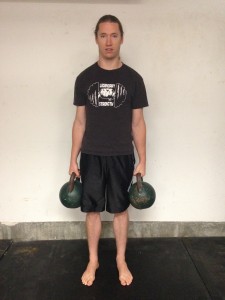A series of exercises, somewhat similar but also different in several ways, are the carrying exercises.
These are similar in that your body must work to support a load in one position. Which position you use will depend on what you’re going for. While there are several, I’m going to be discussing one of my favorites and the simplest to do, the farmer’s walk.
Here’s the cool thing about carrying exercises. They’re both isometric and moving at the same time. Your body must work to support the load in a static way, but at the same time you’re moving around. This is a combination of stability and mobility at the same time. Think about it. You tend to stand or sit in one position through most exercises. And in those that have you moving a lot, there tends not to be a load besides your body. (Truthfully there is an isometric component in all exercises, but what I’m talking about here is different than that.)
In fact, in the recent podcast with Clay Edgin, as well as many exercises discussed in Strengthen Your Structure, you’ll find this taken to a further level than most have tried.
When you can combine the support of a heavy load with the ability to move well, you have one good example of athleticism. And it can be lots of fun too!
What is the Farmer’s Walk?
The name of this exercise goes back many years to when it was much more common for people to be working on farms. A wide variety of tools, bags, pails of water and much else had to be carried around. Often this was done in the hands, with the arms hanging by the sides.
You can do this exercise with any tool but there are a few that work better than others. The optimal one is what are called farmer’s walk bars. Not everyone has these, but they are specifically made to handle fairly heavy weights in this exercises.

About to make the turn with the heavy farmers walk implements.
Another good option is kettlebells. While these typically don’t get too heavy for many people a large pair of kettlebells can provide quite the challenge. And even if you don’t have big weights you can just extend the time and distance.

A pair of kettlebells make for an easy way to do the farmer’s walk.
The thicker the handle the more grip work involved. Dumbbells would work too, and if you want to tax the fingers even more, slap a pair of fat gripz on them. Another solution would be to wrap a small towel around the handle.
Some people use a trap bar for the farmer’s walk. This too will allow you to handle a good size load. The only problem here is safety. If you trip the bar is coming down with you and it could end badly.
How to do the Farmer’s Walk
All you do is pick up the weight and start walking. It’s not complicated (though there are more complicated versions you can do).
Carrying exercises are great to use as a finisher in your workouts, that is the last thing before you call it a day in the gym. You can go heavy and do several sets. You can also go lighter and cover a longer distance of go for time.
Just this past weekend I did a bit of a longer set than I normally do. With two 70 lb. kettlebells in hand I walked all around for five minutes non-stop. My hands and traps were pretty fried at the end of that.
This is functional training. Why? Because this is exactly how you often have to carry things.
It’s funny, but later that day I was carrying a heavy bag of groceries in one hand and a bag full of tools in the other from my truck to my house. I was doing a farmer’s walk in real life, just like I had done hours earlier in the gym.
Of course, this is just one of several carrying exercises you can do. There are four main positions you can use, and if you work all of these I dare say your structure will likely be pretty strong, yet with mobility at the same time. This is also probably the least challenging of the bunch, but that also makes it an excellent place to start.


Comments
Great stuff, Logan – as always. I like how your posts have applications to the real world. Besides, this is a great way to get the whole structure ready for the ski season! Thanks for your fine work. Tom